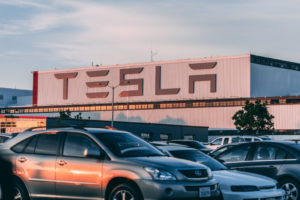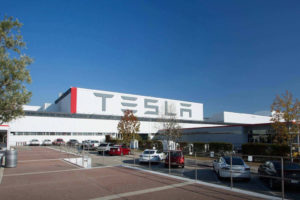Sick of long waits for your electric dream machine? Tesla’s not your grandpa’s car factory. If the thought of cookie-cutter production lines leaves you colder than a battery in a blizzard, you’re in for a warm surprise.
Here’s the scoop: This post will ride shotgun through Tesla’s game-changing manufacturing practices—secrets that are speeding your ride from blueprint to driveway.
Quick Takeaways:
- Tesla’s vertical integration and single-piece casting reduce manufacturing complexity and accelerate production timelines.
- Gigapresses in Tesla’s facilities lower the number of parts per vehicle, enhancing precision and sustainability in production.
- Tesla’s continuous innovation influences industry standards, prompting a shift towards smarter, more efficient car manufacturing processes.
What’s the Secret Sauce in Tesla’s Manufacturing?
Tesla’s approach to manufacturing is like no other in the auto industry. It’s all about innovative techniques that crank up efficiency while trimming down the time it takes to get from raw materials to a sleek, ready-to-drive electric vehicle. Vertical integration is the cornerstone of their success. This isn’t just jargon; Tesla’s got its hands in nearly every part of the production process, which is pretty rare critter in the industry. By keeping a tight grip on the majority of its manufacturing, Tesla can swiftly tweak its car designs, pivot in response to supply chain hiccups, and introduce groundbreaking tech faster than you can say “zero emissions.”
But it’s not just about control. Tesla’s innovation mojo extends to how they build their cars, like using a single-piece casting for the Model Y chassis instead of the traditional multi-part approach. This unique strategy cuts down on labor, reduces the potential for errors, and simplifies the whole assembly process. Talk about a game-changer! Additionally, Tesla constantly iterates their production line, incorporating real-time feedback from the vehicles themselves and their manufacturing processes to iron out kinks and boost empowerment.
How Does Tesla Keep Its Robots Busy?
Robots have become Tesla’s best buds in churning out cars. These aren’t your average run-of-the-mill assembly line bots either; we’re talking sophisticated machinery capable of handling intricate tasks with the finesse of a master craftsman. They weld, rivet, and work alongside humans to piece together electric dreams on wheels. And it’s a win-win scenario—robots boost production rates through the roof and also take on the heavy lifting to keep their human coworkers on the safe side.
In Tesla factories, it’s not only about how many robots they have—it’s about how smart they’re used. Automation is the name of the game, allowing Tesla to produce a Model 3 in a fraction of the time it takes to bake a pie. Big names in robotics like Kuka and Fanuc are the MVPs on Tesla’s team, ensuring that every car part is placed with pinpoint accuracy—down to the millimeter. This relentless pursuit of precision ensures that every Tesla rolling off the line is built to meet Elon’s exacting standards.
Are Tesla’s Factories Really That Different?
If you’re wondering whether Tesla’s Gigafactories are just more of the same old, same old—think again. Tesla’s factories are to traditional car manufacturing what smartphones are to rotary phones. Heck, these facilities are colossal, efficient, and smarter by design. For starters, the scale of these behemoths is nothing short of jaw-dropping. Take the Gigafactory in Nevada; it’s planned to be the biggest building in the world by footprint.
But it’s not just size that makes them stand out—Tesla’s factories bake in sustainability from the ground up. Solar roofs and renewable energy power stations are part of the plan, working towards a net-zero energy factory. Inside, the layout is optimized for smooth workflow, reducing the need for parts to travel long distances which, in turn, slashes manufacturing time.
When it comes to advanced production techniques, Tesla’s Gigafactories go the whole nine yards. They’re pushing boundaries with their gigapresses — gargantuan aluminum casting machines that turn out large chunks of a car’s frame in one go. This approach isn’t just faster; it’s creating stronger, more uniform frames while reducing manufacturing complexity.
And that’s not all. Most factories have to stop the assembly line to tweak their production process; Tesla’s factories introduce changes on the fly. It’s like upgrading the aircraft’s engine while still in midflight—audacious, but oh so effective.
So as you’re digesting this peek behind the curtain of Tesla’s production wizardry, don’t forget—there’s even more innovation under the hood and around the next bend. Tesla’s methods are propelling the entire industry into a future where cars are cleaner, safer, and smarter. Stay tuned for even more insights into how Tesla’s reshaping the world of manufacturing!
What Can You Do with a Gigapress?
Ever heard of the Gigapress? It’s like the Hercules of die-casting machines and a game-changer in how cars are pieced together. Standing tall at the forefront of manufacturing innovation, Tesla has employed this behemoth to streamline their vehicle production like never before.
Gigapress is massive. So, what’s the magic it brews? Simply put, it spits out large sections of a car’s framework in one go. You might think big deal, right? But this means slashing the number of individual parts required – and we’re talking about reducing hundreds of components into a single piece. That’s a logistical symphony, cutting the assembly time and costs like a hot knife through butter.
Here are the knock-on effects:
- Parts reduction: We’re seeing a huge drop in the number of parts needed, making the assembly line cleaner and leaner.
- Precision Engineering: When you’ve got fewer parts, you’ve got fewer headaches over alignment and fitting issues. This means the build quality skyrockets.
- Cost Efficiency: Manufacturing efficiency translates to cost savings. And who doesn’t love a lean price tag?
- Sustainability: With less material waste and a simplified supply chain, we’re talking greener production. Mother Earth gives a nod of approval here.
So, buckle up because it’s not just about making parts; it’s about reimagining the manufacturing blueprint, and Tesla’s doing it with gusto.
Is Tesla Shaping the Future of Car Manufacturing?
Rumor has it, when Elon tweets, the industry listens. But it’s not just social media buzz; Tesla’s manufacturing moves are truly stirring up a storm. They’re not just bending metal differently; they’re bending minds.
The Gigapress and other innovations are pointing to a potential seismic shift in car manufacturing. Imagine a future where assembly lines are sleek, robots dance to a tune of efficiency, and vehicles are pumped out with the reliability of Swiss watches – Tesla is drawing the blueprint for that future.
Consider this:
- Adoption by Others: When an industry big dog learns a new trick, the pack follows. Expect to see other automakers poking their heads into the world of mega castings and simplified assembly.
- Revolutionized Supply Chains: Tesla’s approach could spark a reshaping of global supply chains. We’re likely to see a ripple effect as companies strain to catch up, making the “Tesla way” the new normal.
- Innovation Breeds Innovation: Tesla’s daring approach is a wakeup call – urging the old guard to innovate or risk playing second fiddle. We’re in for a series of one-upmanship, and end consumers get to reap the benefits.
Now, here’s a nugget most overlook: the ripple in the talent pool. Traditional manufacturing skills could take a backseat to robotics programming and maintenance. The demand for new expertise might light a fire under the education and training sectors to pivot towards modern automotive tech requirements.
In closing, let’s not forget that progress loves company—Tesla is penning a few chapters in automotive manufacturing history, sure. But more importantly, they’re inspiring a novel, more efficient, and potentially greener narrative that the entire industry might soon be narrating.
Remember, folks, you heard it here first – when you see those mega castings and next-gen robots making headlines elsewhere, know that the seeds were planted in Tesla’s garden not too long ago. What a time to be alive and witness the gears of innovation churning, setting wheels in motion for an industry revved up and ready to shift gears into the future.





